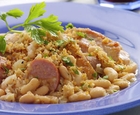|
French Entree
Bean Casserole
Cassoulet
(Serves 12)
These are no ordinary baked beans! Cassoulet is one of the glories of French cuisine, a peasant dish from south central France. It involves numerous steps and many ingredients, but the results are worth it. Make it a day or two ahead of time.
Meat and poultry
5 lb. duck *
2 lb. boned pork loin
1/2 C chicken broth
3 T duck fat
2 lb. boned lamb shoulder (cubed)
3 C onion (diced)
3 cloves garlic (crushed or minced)
2 28-oz. cans whole tomatoes (drained, chopped)
1 C dry white wine
1/2 C fresh parsley (chopped)
1 bay leaf
2 tsp. thyme
salt & pepper
_____________
Beans, etc.
2 lb. dried Great Northern beans
3 qt. water
1 1/2 qt. chicken broth
1 1/2 lb. Polish sausage
1 1/4 lb. lean salt pork
2 onions (peeled and quartered)
bouquet garni (see sidebar)
1/2 tsp. thyme
Meat: preheat oven to 325. Put pork in a small, lidded casserole with 1/2 C chicken broth. Cover and cook 1 1/2 hours. Put duck in a roasting pan and roast along with pork. The duck will take an hour longer than the pork and will be done when the legs move up and down easily. After the duck has given up enough fat, skim off 3 T and put in a large skillet. Brown lamb cubes (add extra duck fat if needed), then remove and set aside. In the same skillet, sauté onions 10 minutes till soft, add garlic and cook 3 more minutes. Add tomatoes, wine, parsley, bay leaf, thyme, salt and pepper. Put lamb back in skillet, cover, and simmer over low heat for 15 minutes. Remove lamb again and set aside. Reserve tomato-wine liquid and set aside.
Beans: in a large pot add the beans and 3 qt. water, bring to a boil for one minute, then remove from heat and let stand for 1 hour. When the beans have plumped up, add 1 1/2 qt. chicken broth, sausage, salt pork, quartered onions, and thyme. Bring to a boil, skimming off scum. Reduce heat and simmer, uncovered, for 30 minutes. Remove sausage and set aside. Cook 15 more minutes, or until beans are barely tender. (Don’t let them get mushy; remember, they have more cooking to do.) Discard onions. Drain beans and save their liquid for moistening during baking. Also save salt pork and set aside with sausage.
Assembly: preheat oven to 350. Slice pork into bite-sized pieces. Carve duck, removing wings, legs and skin. Cut into bite-sized pieces. Slice sausage. Use a large 10-12 qt. casserole and begin layering, first with 1/3 of the beans, then with 1/2 each of the lamb, sausage, pork, and duck. Add another layer of beans and the rest of the meat. Finish with a top layer of beans. Garnish the top layer with legs and wings.
In a bowl, combine the tomato-wine sauce with 3 C bean liquor, and pour over casserole. Save remaining bean liquor in case cassoulet becomes dried out during cooking.**
Bake uncovered for 2 hours, adding more bean liquid if necessary. Serve with green salad and a loaf of crusty French bread. Absolute yum!
* Cassoulet has many, many variations. Feel free substitute or leave out any of the meats that are hard to come by. Use chicken or turkey, say, instead of duck, or skip the pork (though not the sausage!).
** You can refrigerate the cassoulet at this point and bring to room temperature before the final baking step. Just be sure to allow plenty of time (about 2 hours) for the casserole to reach room temperature before putting it in the oven (uncovered) for the last 2 hours. And remember to save the bean liquid for moistening.
| See more French recipes |
|
|
Tips & Glossary
Bouquet Garni: (boo-kay gar-nee) bundle of herbs tied together with string or wrapped in cheese cloth square; usually parsley, thyme, bay leaf, and peppercorns. Flavor is released during long cooking.Remove before serving.
Chervil: (sher-vil) related to parsley but has a delicate anise flavor. Long cooking kills flavor, so add at the last minute.
Cornichon (kor-nee-shon) teeny-tiny pickle, served with pates & smoked meats; found in specialty food stores.
Fines Herbes: (feen-airb) mix of finely chopped herbs: parsley, chives, tarragon, & chervil. Not as strong as a bouqet garni. Buy it at most grocery stores.
Fromage: (fra-mahj) Cheese! The French eat more than any nationality, 45 pounds per capita per year; and the country makes more cheeses than any other country, about 400.
The three great pedigreed French cheeses are:
• Brie (East of Paris)
• Camembert (Normandy)
• Roquefort (Southwest France, from sheep’s milk)
There are also wonderful lesser-known cheeses:
• Beaufort (Rhone Alps, hard, yellow Gruyere-type)
• Chevre (Loire Valley, soft, goat’s milk)
• Comte (Alps region, hard, yellow Gruyere-type)
• Emmental (Alps region, “Swiss” cheese with holes)
• Gruyere (hard, yellow cheese—originally French, now most is Swiss)
• Tomme (means “cheese”; soft, many varieties, all from skim milk)
Herbes de Provence (airb-duh-pro-vonce): mix of dried herbs, usually thyme, rosemary, marjoram, basil, & bay leaf Can be found at most grocery stores.
Mutarde: (moo-tard), mustard. Most famous:
• Dijon ( from the town in Burgundy)
• Meaux (from Meaux, east of Paris; whole-grained; made by Pommery).
Nicoise Olive: (nee-swaz- oh-leev) small, purplish-black olive with a mellow, nutty flavor; used primarily in Salade Nicoise. The Picholine variety is a green, medium-sized olive with a light, nutty flavor.
Roux: (roo) paste-like mix of melted butter and flour, into which liquid is gradually added. The basis of every classic French sauce.
Basic Roux: 1 part butter to 1 part flour. Melt butter and add flour, stirring vigorously, till it becomes a paste-like consistency. At this point, add slowly whatever liquid your recipe calls for
|
![]()
![]()